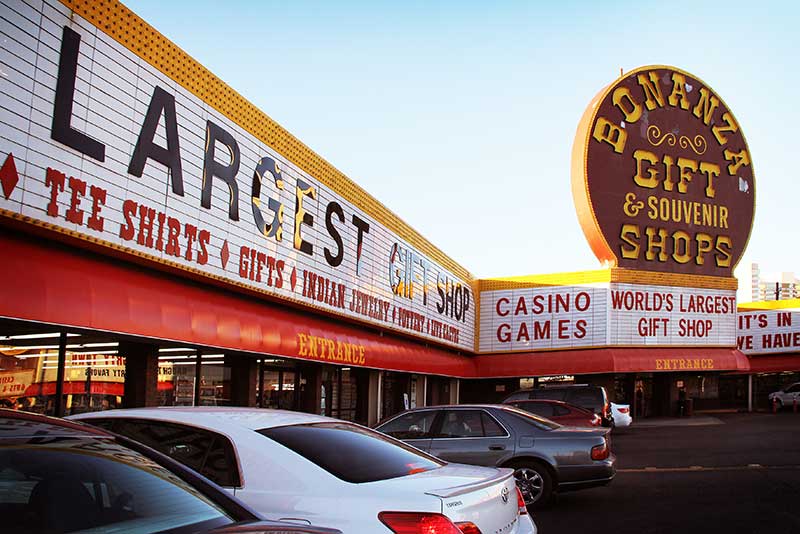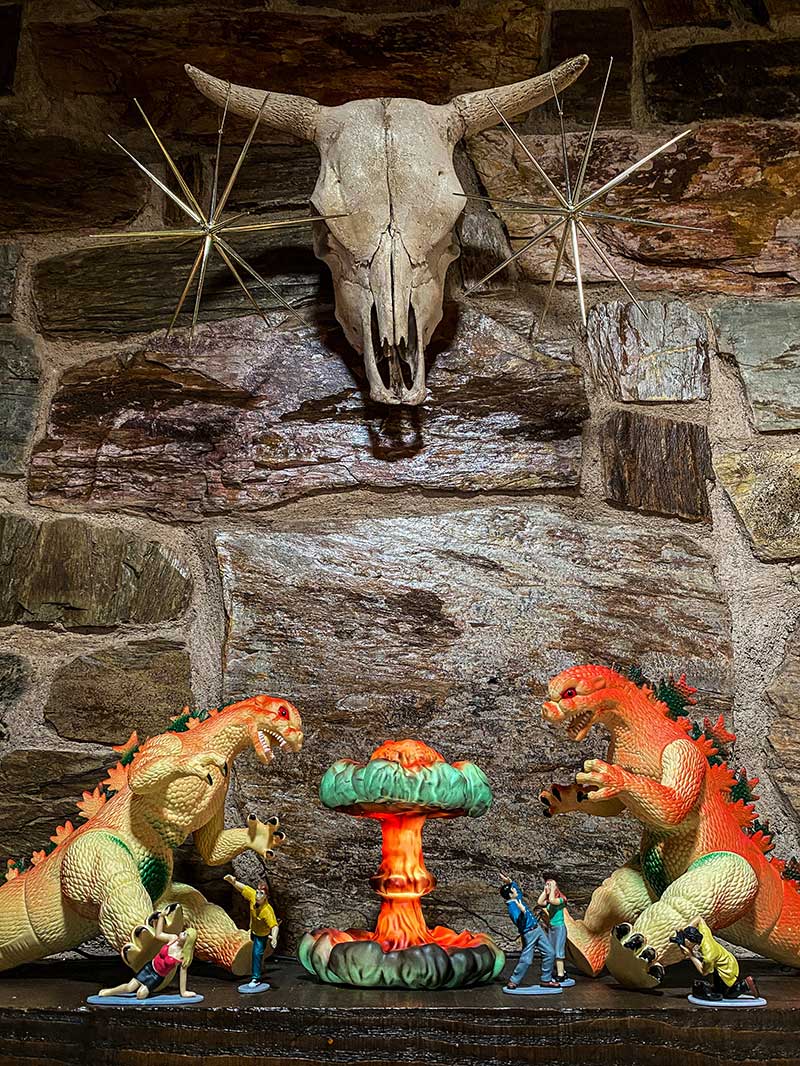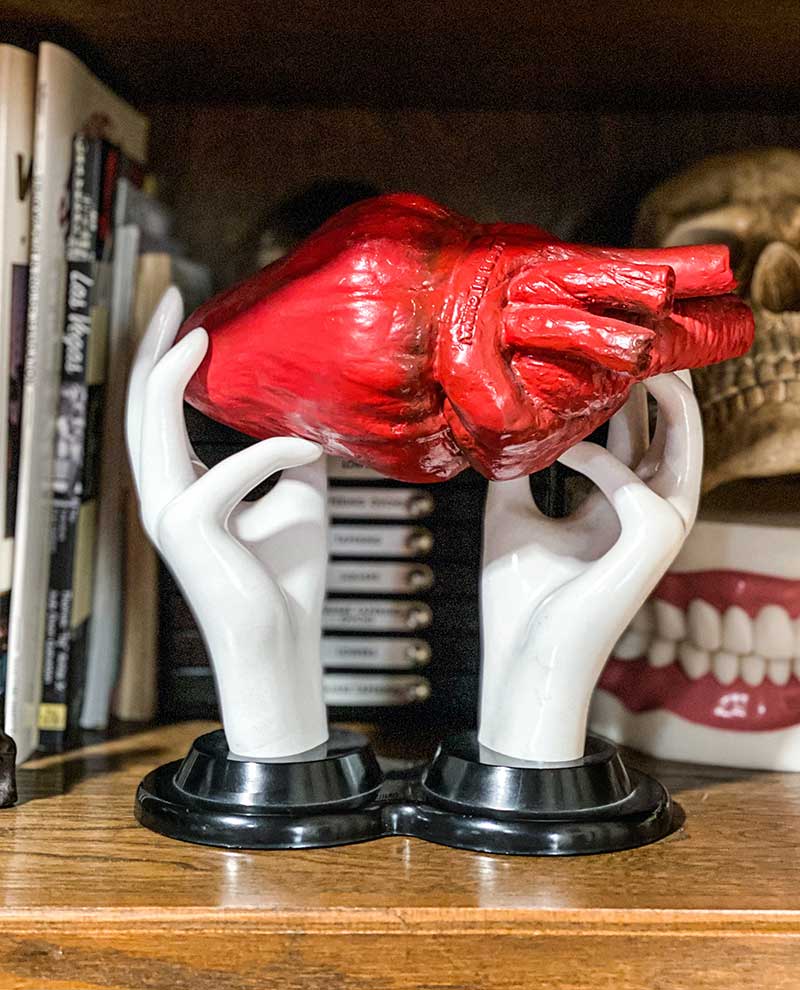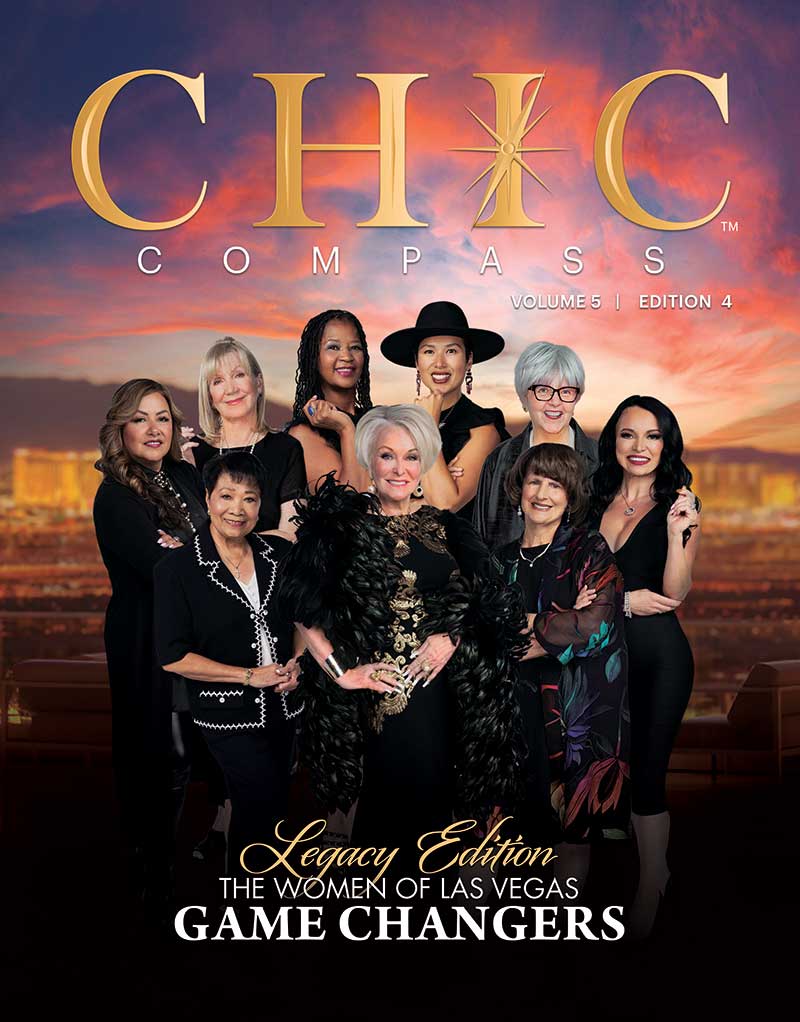
Photo of Lynn Morris by James Stanford – 35mm Analog Film Portrait (2015)
‘Little Feller’ Lynn Morris
A Las Vegas Art Pioneer
BY DR. GEMMA MARMALADE
Julia ‘Lynn’ Morris is Las Vegas’s answer to the smallest atomic bomb you didn’t see detonate, but everyone felt her impact. In a town that screams to be seen and where fleeting expressions of outrageousness are commonplace, Morris has been a modest yet enduring powerhouse of art business (and funny business) for over forty years.
I’m hardly the one to tell this tale, given that I only rocked up to town for the first time in 2015—and that as a naïve British tourist. Like any visitor fresh off the tarmac at the then McCarran, now Harry Reid Airport, I was aware of some iconographies for my Las Vegas bucket list that I just had to tick off. After an incomprehensibly large, vodka-infused, slushy offering on the Strip, I bounded to Bonanza: The World’s Largest Gift Shop. Its famous kitsch was something I felt I had known indirectly for a very long time. I can’t recall any explicit place or time I learned about it. Instead, it seemed to firmly pre-exist in my mind’s eye from many informational sources in the United Kingdom. Fashion photographs; references in popular media, films, and TV shows – (notwithstanding it being the bizarrely chosen shopping location by 9/11 terrorists prior to their World Trade Center attack) – Bonanza’s pervasive allure penetrated my awareness, and like a slutty moth to a chintzy flame, I was ready for what ‘tut’ (as the British like to call it) I could swag.
Apart from the haul of funny gifts and brilliant mementos for friends and family back home, including having my photograph taken in front of the store for cheesy posterity, I didn’t anticipate this experience would awaken my own aesthetic and cultural interests in a way that has since significantly informed my professional and creative research as both an artist and academic. I knew Las Vegas was a natural home for my typically ridiculous performance art spectacles, and Bonanza would become a vital prop supplier. Eventually, and through a complexly magical series of serendipity, I came to learn the boss behind Bonanza, the person who coined “The World’s Largest Gift Shop” in a town built on silver dollars – and so much more – was the petite irrepressibly brilliant and undeniable dark horse: Lynn Morris.
A Las Vegas native, excusing her first six months in Idaho, Morris’ family flourished in the Valley during the 1950s and 60s. Bruce H. Morris worked in and ran a string of hotel gift shops for CT Harris, including The Stardust, The International Hilton, and The Desert Inn, to name a few. Bruce eventually developed his own souvenir businesses with partner John Lonetti around key locations in the heart of the city, Fremont Street, as tourists flooded in. With business booming, L&M Incorporated needed an ambitious and capable manager to run the show, and a state-wide recruitment search commenced. What they didn’t expect was the store’s trusted help, who had worked in the warehouses from the tender age of eight to twenty, would step up. In 1971, Bruce came to learn that his daughter’s keen observation of business, teamed with her BFA in Art History from UNLV, would become a winning formula that created a zeitgeist of pop culture and a beacon that drew the crowds from across the globe for decades.

Photo of Bonanza – The World’s Largest Gift Shop (2012) by The Erica Chang
“It appealed to my sense of the absurd,” says Morris, who also quipped that L&M had no idea the name of their company already had the initials of their best asset. If this wasn’t enough, Morris became yet another female cultural leader of Las Vegas who helped define the iconic ‘Glitter Gulch,’ not simply as a hugely successful business owner but by what the business did for the grassroots art movement of Las Vegas. Morris was one of the original minds who conceived and instigated the now thriving and ever-expanding Las Vegas Arts District.
In 1984, Morris made a ‘souvenir’ purchase of her own. One early Sunday August morning at City Hall, both wearing bow ties and with zero guests, Lynn married local artist James Stanford. Even though this irked the Justice of the Peace performing the ceremony as it interrupted the Dodgers game playing live in Eastern Time, her union with Stanford heralded their status as a power couple on the local arts scene. After assimilating with the then female-led Las Vegas Contemporary Arts Collective, known as ‘CAC,’ Morris, amongst others, helped create its new future in the early nineties. With the CAC’s sole purpose to platform and elevate the talent of Las Vegas creatives to a broader cultural audience, its growth throughout the decade saw it shift locations from its origin on Maryland Parkway to Downtown. On a hunch this could become a fresh and hip off-strip location, the opening event of the CAC at the then-titled Urga Building on Charleston Boulevard drew crowds in the thousands. The CAC and other pioneers of the area built upon this art audience precedent long before First Friday and any designation of it as an ‘Arts District.’

Photo of tentacle from Morris’ home by Gemma Marmalade
Morris’ instinct for both art and business coalesced. The Bonanza Store, by then under exclusive ownership and direction of Morris, was the steadfast financial engine that funded this uptick of home-grown creative industry. Just a year later, CAC made its final relocation to the fledgling Arts Factory, a stone’s throw from the Urga, and cemented the multi-organizational creative home of Downtown Las Vegas. After renovating the upper floors to incubate its creative industries, she co-founded Smallworks Gallery, one of the first commercial galleries in the area, with Stanford and artist Kathleen Nathan. Directly next door, Morris set about creating her own bespoke concept space, Lost Vegas Gallery. So ahead of its time that even a contemporary Las Vegan might struggle to comprehend its genius, Lost Vegas Gallery deftly straddled a cerebral, experiential art space with a commercial souvenir gift shop. Not only did this generate a cash lifeline to help sustain Smallworks Gallery, but it was also a remarkably unique location that featured Vegas-derived work by artists, including the ‘Elvis Throne,’ colloquially known as the ‘Elvis Death Toilet’ by John deFazio. If a ceramic homage to the bowel-burdened Presley doesn’t illustrate the camp eye of Morris, please read on.

Photo of Lynn Morris
Morris was initially informed by the aesthetic (or lack thereof) of being raised in the sobriety of Mormonism. Daniel T. Jenkins describes this condition in relation to art and theology as “not to think more highly of ourselves than we ought to think.” Morris’ protest of this faith system embraced the excess, exotic, and indulgence in the artifacts of her colorful world, as was her rejection of patriarchal femininity illustrated in her subtly playful androgynous style of dress. Rebellion from normativity became her business, both literally and figuratively. However, a sliver of Jenkin’s point remained true of Morris’ psyche – Lynn made space for the fantastic without demanding that space herself. She was not a monopolizer of the limelight like so many debutants drawn by the glitzy potential of the Valley. She was the brains, the facilitator, the enabler, and the grit that underpinned and expedited unprecedented creative growth in and for Las Vegas through the fiscal foundations she built almost entirely alone.
Today, one might hasten to think that the former owner of Bonanza – who, in its heyday, made her the Las Vegas souvenir maven – might be a ball-breaker broad bankrolled by her mobster love conquests. Instead, Morris is an impish, self-effacing ‘tomboy’ juxtaposed by her pistol whip wit, illustrated by her iconic choice of Bonanza Store signage: ‘If it’s in stock, we have it.’ Even whilst retired, Morris continues to be a dynamo of observant and relentless persistence to support emerging creativity. After a dormant period through various other sets of hands, the CAC entered yet another new era in 2023 with Morris at the helm as President, flanked by an international team of art experts. Its focus is to preserve the CAC’s historical contributions to the Las Vegas art scene made possible by the many artists and curators who exhibited between the 1980s – 2000s, as well as created future arts and culture opportunities for the community.
With wickedly clever brilliance, she maintains her keen eye for visual language and its incisive cultural coding teamed with her unextinguishable imagination. Morris cites American artist Joseph Cornell as a key influence on her personal style of curatorship. Skillfully turning the avant-garde to avant-gauche, her home in the Scotch Eighties is an ever-evolving treasure trove ‘museum’ of carefully staged art and artifacts, where in just a few strides, you’ve likely met an assemblage of a Martini drinking Godzilla feasting on the guts of a Fez-wearing human anatomical model.

Photo of Atomic tableau from Morris’ home by Gemma Marmalade
Las Vegas and its loyal fans love a brazen tale of audacity, debauchery, and infamy. Indeed, this global fascination is a likely element of what initially drew me in eight years ago, just like it has for the millions of visiting tourists year on year, who fly in and then out, freshly laden with their vacation trinkets and holiday ephemera. However, it was through the good fortune of my staying just long enough to peer beyond the superficial shop front of Vegas and meeting the seminal Lynn Morris that a very different and more nuanced story emerged. The truly radical extreme is, in my view, best illustrated in Las Vegas’s few unsung and unanticipated heroes. Poet Rainer Maria Rilke says, “Go to the limits of your longing,” meaning that to fully step into life, it is not through the ego self. Instead, it is through an unapologetic immersion in the plurality of extraordinariness in human nature. From an anthropological perspective, Ernest Becker says, “Society itself is a codified hero system, which means that society everywhere is a living myth of the significance of human life, a defiant creation of meaning.” Morris’ unpretentious and subversive magic truly resides in the paradox between what is conventionally perceived and its unconventional counterpart.

Photo of Neon designed by Morris (1994) by Gemma Marmalade
Once dangerously underestimated after the exponential growth of his businesses, Bruce Morris said to the newly successful Lynn, “You’re the son I always wanted,” to which she effortlessly replied, “I’m the daughter you always needed.” This cool, intelligent hutzpah, combined with her cultural contribution to a city that owes her so much, transforms her into the richest and most formidable example of heroism one might ever be lucky enough to encounter. The trouble is, how conscious one is of such an unassuming yet powerful encounter with Lynn Morris is much like this witness testimony from the 1962 Nevadan nuclear explosion codenamed ‘Little Feller’… “Well, you could have easily missed it, but boy, did it kick ass.”

Photo of tableau from Morris’ home by Gemma Marmalade



Fantastic tribute to a fantastic human being! My boss for 30 years!!